2.kafka集群环境搭建
2.1.集群主机规划
| 机器名称 | ip/mac地址 | 硬件资源 | 安装服务 | |
|---|---|---|---|---|
| 1 | cdh1 root/server123 | 192.168.80.100,00:50:56:2B:5B:EF | cpu:2核 , 内存:2.5g ,硬盘20g ,网卡:千兆网卡 | jdk、zookeeper、kafka |
| 2 | cdh2 root/server123 | 192.168.80.101,00:50:56:39:23:67 | cpu:2核 , 内存:2.5g ,硬盘20g ,网卡:千兆网卡 | jdk、zookeeper、kafka |
| 3 | cdh3 root/server123 | 192.168.80.102,00:50:56:3E:3A:0B | cpu:2核 , 内存:2.5g ,硬盘20g ,网卡:千兆网卡 |
说明:集群主机之间需要配置ssh免密码登录
免密登录参考:https://www.cnblogs.com/luzhanshi/p/13369797.html
#zookeeper官网地址:
http://zookeeper.apache.org/
一个分布式协调服务,管理我们的集群
官网提供配置说明:https://zookeeper.apache.org/doc/current/zookeeperStarted.html
/usr/local/zookeeper/:
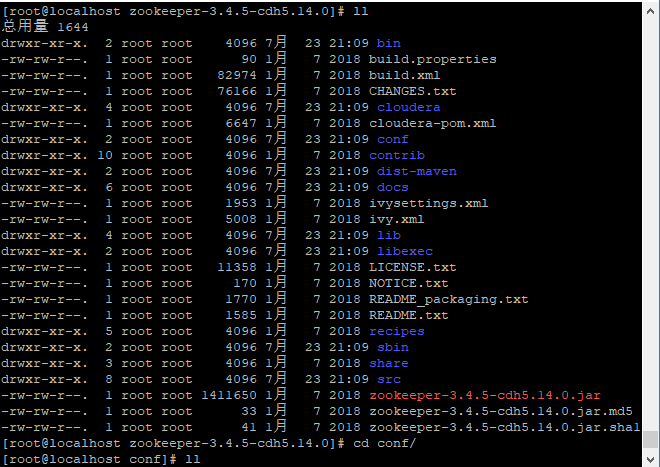
菜单进入conf目录下面,将zoo_sample.cfg复制一份到本目录并改名为zoo.cfg
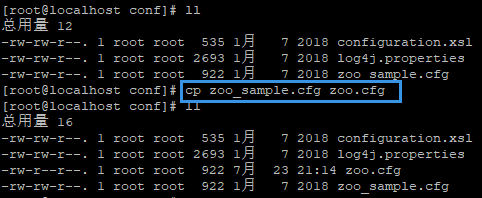
vim编辑该配置文件:
#编辑文件: vim zoo.cfg ---------------------------------------------------------------------------- # The number of milliseconds of each tick #时间单元,zk中的所有时间都是以该时间单元为基础,进行整数倍配置(单位是毫秒,下面配置的是2秒) tickTime=2000 # The number of ticks that the initial # synchronization phase can take #follower在启动过程中,会从leader同步最新数据需要的最大时间。如果集群规模比较大,可以调大该参数 initLimit=10 # The number of ticks that can pass between # sending a request and getting an acknowledgement #leader与集群中所有机器进行心跳检查的最大时间。如果超出该时间,某follower没有回应,则说明该follower下线 syncLimit=5 # the directory where the snapshot is stored. # do not use /tmp for storage, /tmp here is just # example sakes. #事务日志输出目录 dataDir=/usr/local/zookeeper/zookeeper-3.4.5-cdh5.14.0/zkdatas
# the port at which the clients will connect #客户端连接端口 clientPort=2181 # the maximum number of client connections. # increase this if you need to handle more clients #maxClientCnxns=60 # # Be sure to read the maintenance section of the # administrator guide before turning on autopurge. # # http://zookeeper.apache.org/doc/current/zookeeperAdmin.html#sc_maintenance # # The number of snapshots to retain in dataDir #需要保留文件数目,默认就是3个 autopurge.snapRetainCount=3 # Purge task interval in hours # Set to "0" to disable auto purge feature #自动清理事务日志和快照文件的频率,这里是1个小时 autopurge.purgeInterval=1 #集群服务器配置,数字1/2/3需要与myid文件一致。右边两个端口,2888表示数据同步和通信端口;3888表示选举端口 server.1=域名1:2888:3888 server.2=域名2:2888:3888 server.3=域名3:2888:3888
上面我的域名设置是my.server1;my.server2;my.server3
#创建数据存储目录: mkdir -p /usr/local/zookeeper/zookeeper-3.4.5-cdh5.14.0/zkdatas
#创建myid:
cd/usr/local/zookeeper/zookeeper-3.4.5-cdh5.14.0/zkdatas
touch myid
并编辑myid内容为1
server02和server03为基础
#分发到node02节点,并修改myid内容为2: scp -r zookeeper-3.4.5-cdh5.14.0/ server02:$PWD #分发到node03节点,并修改myid内容为3: scp -r zookeeper-3.4.5-cdh5.14.0/ server03:$PWD
分别在node01/node02/node03节点启动/停止: /usr/local/zookeeper/zookeeper-3.4.5-cdh5.14.0/bin/zkServer.sh start/stop
#查看集群状态: /usr/local/zookeeper/zookeeper-3.4.5-cdh5.14.0/bin/zkServer.sh status
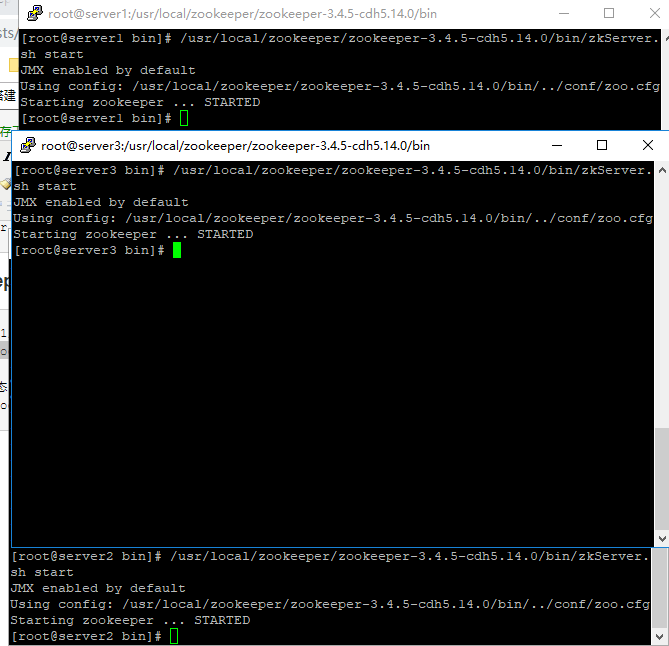
如果在查看状态的时候出现如下错误:

出现这个问题有一下几种可能性:
1.防火墙没有关闭,就是对应的集群端口没有开放,所以各个节点之间没办法通信(zoo.cfg中最后自己配置的内容(包括2888端口和3888端口)以及zookeeper自己的2181端口);
2.zookeeper中conf目录下的zoo.cfg配置文件有问题,查看日志dataLog文件的目录,以及data数据文件的目录是否正确;
3.myid文件中的内容是否和zoo.cfg中配
开放上述端口:

再次测试:


下载kafka
#kafka官网:
http://kafka.apache.org/
http://kafka.apache.org/downloads

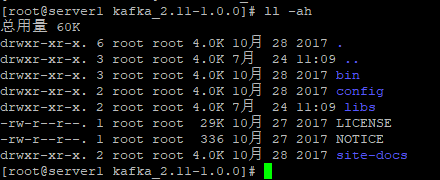
/usr/local/kafka/kafka_2.11-1.0.0/config
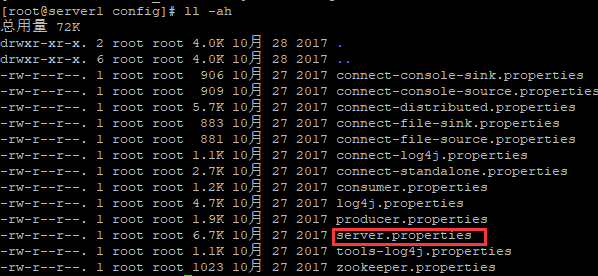
# Licensed to the Apache Software Foundation (ASF) under one or more # contributor license agreements. See the NOTICE file distributed with # this work for additional information regarding copyright ownership. # The ASF licenses this file to You under the Apache License, Version 2.0 # (the "License"); you may not use this file except in compliance with # the License. You may obtain a copy of the License at # # http://www.apache.org/licenses/LICENSE-2.0 # # Unless required by applicable law or agreed to in writing, software # distributed under the License is distributed on an "AS IS" BASIS, # WITHOUT WARRANTIES OR CONDITIONS OF ANY KIND, either express or implied. # See the License for the specific language governing permissions and # limitations under the License. # see kafka.server.KafkaConfig for additional details and defaults ############################# Server Basics ############################# # The id of the broker. This must be set to a unique integer for each broker. #每个broker在集群中的唯一标识,不能重复 broker.id=0 #端口 port=9092 #broker主机地址 host.name=server1 ############################# Socket Server Settings ############################# # The address the socket server listens on. It will get the value returned from # java.net.InetAddress.getCanonicalHostName() if not configured. # FORMAT: # listeners = listener_name://host_name:port # EXAMPLE: # listeners = PLAINTEXT://your.host.name:9092 #listeners=PLAINTEXT://:9092 # Hostname and port the broker will advertise to producers and consumers. If not set, # it uses the value for "listeners" if configured. Otherwise, it will use the value # returned from java.net.InetAddress.getCanonicalHostName(). #advertised.listeners=PLAINTEXT://your.host.name:9092 # Maps listener names to security protocols, the default is for them to be the same. See the config documentation for more details #listener.security.protocol.map=PLAINTEXT:PLAINTEXT,SSL:SSL,SASL_PLAINTEXT:SASL_PLAINTEXT,SASL_SSL:SASL_SSL # The number of threads that the server uses for receiving requests from the network and sending responses to the network #broker处理消息的线程数 num.network.threads=3 # The number of threads that the server uses for processing requests, which may include disk I/O #broker处理磁盘io的线程数 num.io.threads=8 # The send buffer (SO_SNDBUF) used by the socket server #socket发送数据缓冲区 socket.send.buffer.bytes=102400 # The receive buffer (SO_RCVBUF) used by the socket server #socket接收数据缓冲区 socket.receive.buffer.bytes=102400 # The maximum size of a request that the socket server will accept (protection against OOM) #socket接收请求最大值 socket.request.max.bytes=104857600 ############################# Log Basics ############################# # A comma seperated list of directories under which to store log files #kafka数据存放目录位置,多个位置用逗号隔开 log.dirs=/usr/local/kafka/kafka_2.11-1.0.0/kfk-logs # The default number of log partitions per topic. More partitions allow greater # parallelism for consumption, but this will also result in more files across # the brokers. #topic默认的分区数 num.partitions=1 # The number of threads per data directory to be used for log recovery at startup and flushing at shutdown. # This value is recommended to be increased for installations with data dirs located in RAID array. #恢复线程数 num.recovery.threads.per.data.dir=1 ############################# Internal Topic Settings ############################# # The replication factor for the group metadata internal topics "__consumer_offsets" and "__transaction_state" # For anything other than development testing, a value greater than 1 is recommended for to ensure availability such as 3. #默认副本数 offsets.topic.replication.factor=1 transaction.state.log.replication.factor=1 transaction.state.log.min.isr=1 ############################# Log Flush Policy ############################# # Messages are immediately written to the filesystem but by default we only fsync() to sync # the OS cache lazily. The following configurations control the flush of data to disk. # There are a few important trade-offs here: # 1. Durability: Unflushed data may be lost if you are not using replication. # 2. Latency: Very large flush intervals may lead to latency spikes when the flush does occur as there will be a lot of data to flush. # 3. Throughput: The flush is generally the most expensive operation, and a small flush interval may lead to exceessive seeks. # The settings below allow one to configure the flush policy to flush data after a period of time or # every N messages (or both). This can be done globally and overridden on a per-topic basis. # The number of messages to accept before forcing a flush of data to disk #log.flush.interval.messages=10000 # The maximum amount of time a message can sit in a log before we force a flush #log.flush.interval.ms=1000 ############################# Log Retention Policy ############################# # The following configurations control the disposal of log segments. The policy can # be set to delete segments after a period of time, or after a given size has accumulated. # A segment will be deleted whenever *either* of these criteria are met. Deletion always happens # from the end of the log. # The minimum age of a log file to be eligible for deletion due to age #消息日志最大存储时间,这里是7天 log.retention.hours=168 # A size-based retention policy for logs. Segments are pruned from the log unless the remaining # segments drop below log.retention.bytes. Functions independently of log.retention.hours. #log.retention.bytes=1073741824 # The maximum size of a log segment file. When this size is reached a new log segment will be created. #每个日志段文件大小,这里是1g log.segment.bytes=1073741824 # The interval at which log segments are checked to see if they can be deleted according # to the retention policies #消息日志文件大小检查间隔时间 log.retention.check.interval.ms=300000 ############################# Zookeeper ############################# # Zookeeper connection string (see zookeeper docs for details). # This is a comma separated host:port pairs, each corresponding to a zk # server. e.g. "127.0.0.1:3000,127.0.0.1:3001,127.0.0.1:3002". # You can also append an optional chroot string to the urls to specify the # root directory for all kafka znodes. #zookeeper集群地址 zookeeper.connect=server1:2181,server2:2181,server3:2181 # Timeout in ms for connecting to zookeeper #zookeeper连接超时时间 zookeeper.connection.timeout.ms=6000 ############################# Group Coordinator Settings ############################# # The following configuration specifies the time, in milliseconds, that the GroupCoordinator will delay the initial consumer rebalance. # The rebalance will be further delayed by the value of group.initial.rebalance.delay.ms as new members join the group, up to a maximum of max.poll.interval.ms. # The default value for this is 3 seconds. # We override this to 0 here as it makes for a better out-of-the-box experience for development and testing. # However, in production environments the default value of 3 seconds is more suitable as this will help to avoid unnecessary, and potentially expensive, rebalances during application startup. group.initial.rebalance.delay.ms=0
#创建数据存储目录: mkdir -p /usr/local/kafka/kafka_2.11-1.0.0/kfk-logs
mkdir -p /usr/local/kafka/kafka_2.11-1.0.0
然后:
#分发到node02节点:
scp -r /usr/local/kafka/kafka_2.11-1.0.0/ server2:$PWD
#分发到node03节点:
scp -r /usr/local/kafka/kafka_2.11-1.0.0/ server3:$PWD

#server2节点 cd /usr/local/kafka/kafka_2.11-1.0.0/config vim server.properties ---------------------------------------------------- # The id of the broker. This must be set to a unique integer for each broker. broker.id=1 port=9092 #server3节点 cd /usr/local/kafka/kafka_2.11-1.0.0/config vim server.properties ---------------------------------------------------- # The id of the broker. This must be set to a unique integer for each broker. broker.id=2 port=9092
#分别在三台节点执行:node01/node02/node03 ##启动kafka集群-daemon(以后台服务方式启动) 后面跟的是以配置文件启动 /usr/local/kafka/kafka_2.11-1.0.0/bin/kafka-server-start.sh -daemon /usr/local/kafka/kafka_2.11-1.0.0/config/server.properties ## 停止kafka集群 /usr/local/kafka/kafka_2.11-1.0.0/bin/kafka-server-stop.sh

查看是否有kafka进程

#查看topic 列表: /usr/local/kafka/kafka_2.11-1.0.0/bin/kafka-topics.sh --list --zookeeper server1:2181,server2:2181,server3:2181 #查看指定topic: /usr/local/kafka/kafka_2.11-1.0.0/bin/kafka-topics.sh --describe --zookeeper server1:2181,server2:2181,server3:2181 --topic itcast_topic #创建topic # --create:表示创建 # --zookeeper 后面的参数是zk的集群节点 # --replication-factor 1 :表示复本数 # --partitions 1:表示分区数 # --topic itheima_topic:表示topic的主题名称 /usr/local/kafka/kafka_2.11-1.0.0/bin/kafka-topics.sh --create --zookeeper server1:2181,server2:2181,server3:2181 --replication-factor 1 --partitions 1 --topic oc_itheima_topic #删除topic /usr/local/kafka/kafka_2.11-1.0.0/bin/kafka-topics.sh --delete --zookeeper server1:2181,server2:2181,server3:2181 --topic itheima_topic
#创建生产者,生产消息 /usr/local/kafka/kafka_2.11-1.0.0/bin/kafka-console-producer.sh --broker-list server1:9092,server2:9092,server3:9092 --topic oc_itheima_topic

发送消息:

#创建消费者,消费消息: /usr/local/kafka/kafka_2.11-1.0.0/bin/kafka-console-consumer.sh --bootstrap-server server1:9092,server2:9092,server3:9092 --topic oc_itheima_topic --consumer-property group.id=my-consumer-g --partition 0 --offset 0
$PWD



